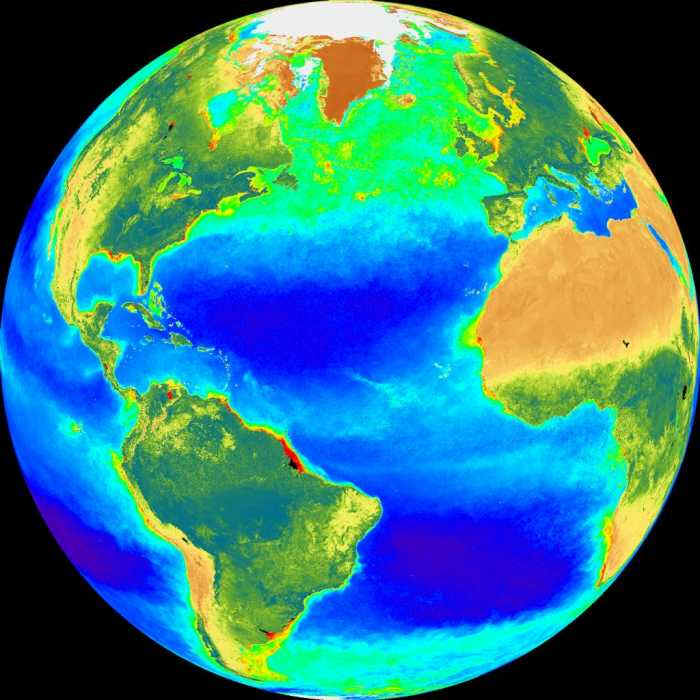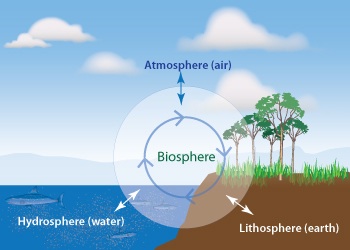The Earth is composed of many organisms, animals, plants, gases, and other natural resources. All physical substances are named matter, and is made from atoms. Matter then is made up of elements, which cannot be broken down by regular chemical means. The Earth's biosphere is closed, and rarely any matter goes in or out. Only matter from space will make it in sometimes. All of the elements found within the biosphere descend from Earth's creation 5 billion years ago. "The biosphere is the thin layer at the surface of the planet where life exists"(Robertson, 2017, 2017, p.30). Inside the biosphere, not only is all life living there, but regenerative patterns, called cycles are taking place everyday, all day long. These cycles "happen at all scales of systems, from the metabolism of a bacterium to the pumping of carbon around the planet to the recycling of fundamental matter in the great star factories of interstellar space" (Robertson, 2017, p.24). Different types of cycles are needed in the biosphere, as they help generate another cycle, and it just continues. These cycles happen in all types of ecosystems within the biosphere.
https://local-brookings.k12.sd.us/biology/images/biosphere.jpg
One thing transferred through systems during the carbon cycle, is carbon, as it is a building block of life. "Plants take CO2 out of the air during photosynthesis, plants are eaten by other organisms and become part of the eating sequence known as the food chain. then when the plants die, they are broken down by microorganisms and become part of the soil. Some CO2 goes back into the air, and into the oceans algae and becomes part of that food chain" (Robertson, 2017, p.24-25). Another essential gas to life is nitrogen. These gases needed in the ecosystems, earth, organisms, air, and water are known as biogeochemical cycles. Phosphorus is created during a cycle, and is called the energy element. Phosphorus cycles through the food chain in the ocean, which is then brought to land through birds. Sulfur is also needed in the biosphere. It comes from the ocean as well, and eventually makes its way to land, to be reused again.
https://upload.wikimedia.org/wikipedia/commons/thumb/d/d5/Carbon_cycle.jpg/1200px-Carbon_cycle.jpg
The earth consists of all these moving parts, that are need for all organisms on Earth to survive and prosper. If we do not have some of these cycles within the biosphere, it would stop working, and no life would be able to survive. We need to start protecting the biosphere. There needs to be regulations on what gets released into the air, because it will disrupt the natural gasses. Also, if the gasses are disrupted, the plants will not grow right, which will then limit the food for other organisms. This cycle will be continuous, and eventually kill the biosphere. As humans using the Earth for our own use, we need to be cautious about what we are doing to the Earth, and how we can help protect it. We need to see that every part of the Earth works together, and if we damage one part, eventually the rest will start to crumble. This is seen through using natural resources and not replenishing them, not wanting to protect natural landscapes, protecting animal populations, and much more. If we start protecting the Earth, it will be able to natural sustain itself, as it has been doing so for 5 billion years.
https://userscontent2.emaze.com/images/1aa4cc0a-d70f-4543-beff-057c5176154d/dc1f93740e43d61cf467f1ae312e00e1.jpg
It is important for humans around the world to realize that the human population is projected to grow every year. This means that there will need to be more resources used, more food, and more emissions will be put out into the biosphere. The Earth's carrying capacity will continue to get smaller until there is nothing left.
Works Cited
Robertson, M. (2017). Sustainability principles and practice. London: Routledge, Taylor & Francis Group.



No comments:
Post a Comment